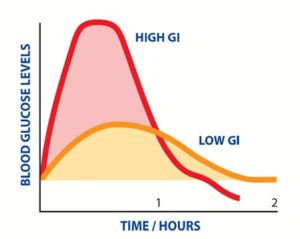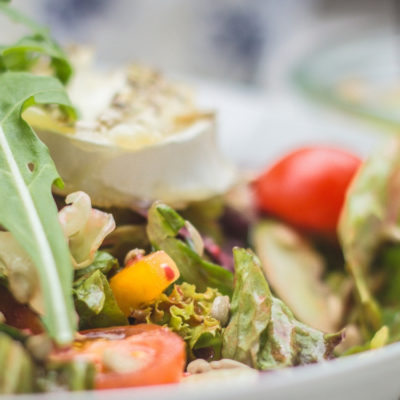There’s a lot of hullaballoo about carbs (carbohydrate) in the media – some say carbs are good while others say they aren’t good for our health. Then there’s glycaemic index or GI.
If it’s all a bit of a mystery to you, you aren’t alone – I get a lot of questions about them, so today’s blog is to clear up some of the misconceptions around carbs and GI.
Carbs
Carbohydrate or carbs is one of the macronutrients, and along with fat and protein as providing our bodies with energy (think kilojoules or calories when I say energy). Check out this blog for more info on macronutrients.
Most foods have a mix of carbs, protein and fat in them, and many foods also provide us with vitamins, minerals, and other nutrients,  depending on what they are. Plant-based foods will usually contain fibre, too.
depending on what they are. Plant-based foods will usually contain fibre, too.
A lot of very healthy foods contain carbs, including fruit, starchy vegies, bread and grains, milk and yoghurt.
A lot of less healthy foods contain carbs, too. They tend to contain a lot more of them and often they are added as sugars or they are foods high in not-so-good fats. You can read about intrinsic and extrinsic sugars, here.
Over the years the foods readily available to us in the supermarket and in take-away stores have evolved and a lot of those foods provide many more carbs than we were eating 30 or more years ago. Serve sizes have grown, too.  Consider the weight of an average slice of bread – when I first graduated as a dietitian in the early ‘90s it was out 30 grams, nowadays it isn’t unusual to have an ‘average’ slice of bread that weighs 40 or 45 grams.
Consider the weight of an average slice of bread – when I first graduated as a dietitian in the early ‘90s it was out 30 grams, nowadays it isn’t unusual to have an ‘average’ slice of bread that weighs 40 or 45 grams.
Basically, it’s easy to eat a lot more carbs nowadays. I’m not saying they are bad for us, it’s just it’s very easy to eat too much of them.
Research shows really high and really low carb diets aren’t so good for our long term health.
Other research shows a lower carb weight loss diet can result in faster weight loss initally but after 6 to 12 months a regular carb weight loss diet can achieve the same amount of weight loss. It’s up to you whether you choose a slightly higher or slightly lower carb diet, either way you can achieve the same end result.
Glycaemic index

Source: https://www.glycemicindex.com/
Now, I’ll move on to glycaemic index. GI is a measure of how quickly a carbohydrate containing food takes to be digested then increase our blood glucose level, and by how much our blood glucose rises.
There is an international standard on how GI is determined and the people at the University of Sydney have a website where they publish GI values for Australian foods. To read more about how GI is measured, check out this page.
Low GI foods are anything with a GI of 55 or less, high GI foods are those over 55. Different factors in foods will affect the food’s GI including what form the carb is in, the food’s fibre content and the type of fibre, the acidity of the food, the salt content of the food, how much fat or protein it contains, and how it has been processed or cooked. Growing conditions can change the GI of some fruit and vegetables. Whether a food is cooked then cooled can affect the GI, too. You can see it’s complicated.
| Low GI foods | Moderate GI foods | High GI foods |
|---|---|---|
| Heavy grain bread | Wholemeal bread | White bread |
| Sourdough bread | Pita bread | Gluten free bread |
| Heavy raisin bread | Rye bread | Lebanese bread |
| Rolled oats | Weet-bix | Instant or 2 minute oats |
| Muesli | Bran flakes | Corn flakes |
| Pasta | Cous cous | Corn pasta |
| Quinoa | Gnocci | Congee |
| Noodles | Rice vermicelli | Jasmine rice |
| Rice noodles | Doongarra or basmati rice | Brown rice |
| Citrus | Paw paw | Watermelon |
| Stone fruit | Rockmelon | Lychees |
| Bananas | Sultanas | Rockmelon |
| Sweet potato | Mango | White (regular) potatoes |
| Legumes, lentils and chickpeas | Instant potato | |
| Dairy and soy milks | Rice milk | |
| Yoghurt | Oat milk |
If you want to search for the GI value for an Australian food have a look here.
Foods which don’t contain any or much carbohydrate don’t have a GI. These include meats, fish, poultry, tofu, nuts, fats and oils, avocado, and some fruits like berries and some vegetables like spinach.
GI is really useful for people who have diabetes, including women with gestational diabetes. Including at least one low GI food at each meal can help manage blood glucose levels.
People who don’t have diabetes can also benefit from including a low GI food at meals, you are more likely to feel fuller for longer so low GI foods can help with weight management.
Tips to lower the GI of a meal
- By including a low GI food at every meal or snack it lowers the GI of the whole meal.
Low GI food + high or medium GI food = medium GI meal
- Instead of serving just cooked white potatoes, cook potatoes, cool them then use as desired. Yes, you can heat them up again if you don’t want potato salad.
- Add something acid to the meal like salad dressing with vinegar or lemon juice.
- Add legumes or lentils to mixed dishes.
- Need to add some sugar? Use less regular white sugar or use a little honey or coconut sugar which has a lower GI.
Glycaemic load
Then there’s GL (oh, no, not another acronym!). Glycaemic Load or GL is a calculation based on the GI of a carbohydrate containing food and how much carb is in that food. To work out how to calculate GL check out this page.
GL is a better predictor than GI on its own of the effect of a food on your blood glucose levels. Basically, what it means is if you eat a lot of a low GI food it can have a similar effect as eating only a small amount of a high GI food. Once again, moderation is the key to healthy eating.
So, to sum up:
- GI is a measure of how rapidly a carb containing food increases your blood glucose level
- There’s no need to give up your bread and potatoes entirely
- Include one low GI food at each meal to lower the GI of whole meal or snack
- Do include carbs in your everyday eating – look for carbs with good nutrition quality
- Don’t overdo the carbs.
Bon appetit!
register here to receive Dale’s blog update in your inbox each week.
contact dale if you would like help to work toward achieving your health goals.






Comments (3)